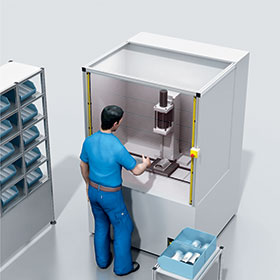

In order to ensure safety, a proper evaluation of the press system and the installation is required with regards to human approach, speed, machine stopping time and distance between the operator and the dangerous area.
Type of protection needed
The protection system on a press should consist of a combination of fixed guards and some form of either optoelectronic protection device or a two-hand control system at the point of opening of the press i.e. where the operator will be interacting with the machine.
Since the operator is expected to work in a situation where (s)he cannot avoid the dangerous where an accident could result in the loss of a limb, the EU standards call for light curtains that fulfils a minimum requirement of SIL3 (safety integration level) and PLe (performance level).
A system that conforms to SIL3 and PLe would be equivalent to the safety category 4 of the old EN standards, now replaced by the new EN12100 standard. A safety category 4 light curtain is self-monitoring and has redundant systems in place to ensure that in the event of a product failure the safety related part of the control system will fail to a safe state. This would mean, were the light curtain to fail, the press would not be able to operate. Safety category 2 (SIL2, PLd) light curtains will operate in a very similar way, but the monitoring and redundancy requirements of the system would not be met.
In South Africa the Driven Machinery Regulations combine regulations for shears, guillotines and presses. The regulations do not specifically mention the protection of the moving parts of the press, unless a section which deals with revolving machinery is considered applicable.
While the regulations state clearly that protection is required, and there are guidelines as to the type of protection that must be used, the regulations are much less stringent than the EU standards.
However, the route that Sick Automation would propose to ensure a safe system would be to follow the EU Machinery Directive and the relevant standards for example EN 693 ‘Safety of Machinery – Hydraulic Press’. By adhering to the EU standards, it can be ensured more has been done than required by the local regulations, thus fulfilling the principles of best practice.
Choosing the protection
Assuming that the press opening at the point of operation is wider than 6 mm, there are three choices of protection equipment; a mechanical guard, two-hand control or light curtain.
Mechanical guards are slowly falling into disfavour because they tend to hinder the operator, have inherent ergonomic issues and slow down production.
The two-hand control system must be made in such a way that the activation can happen only when the operator purposefully operates the two actuating devices. These devices must be mounted between 550 and 600 mm apart, each one beneath a hood that prevents operation by another body part, for example foot or knee. The control system must work in such a way that the activation of both actuating devices happens simultaneously and that reactivation cannot happen unless both actuating devices have been released.
Light curtains must be mounted across the opening to the dangerous area at the point of operation. To ensure that compliance with EU standards, any gap between the light curtain and the body of the press must be less than 75 mm. However, it is generally a good idea to make sure that the body of the light curtain is in line with or slightly overlaps the body/guards on the press.
A resolution of 14 mm is regarded as standard finger width, so by choosing this the requirements of the standard are met. The control system for the light curtain must be configured so that any failure or disconnection of the light curtains must halt the dangerous movement. Reconnection of the light curtains must not automatically start the dangerous movement again, but must require a physical reset.
Special cases
Large presses: typically floor standing presses that allow people to be inside the press mechanical system, or have enough space for someone to be between the light curtain and the press, must have some form of area presence sensing or serial-reset system in place to prevent start-up of the system while there is someone in the dangerous area. Automatic reset is not allowed if the area presence sensing is activated.
PSDI: presence sensing device initiation systems make use of the interruption and automatic reset of the light curtain to initiate the dangerous movement. So, the operator will break the beams to place the work piece in the press, which will prevent any dangerous movement. When the operator removes his hands from the beams of the light curtain, this will be the signal to begin the dangerous movement. This means that the operator does not have to press a start button to activate the press.
PSDI modes require time-outs of the automatic functions, with visible condition indication and a physical reset of the system, to prevent any unintended movement of the machine.
For more information contact Jacque Dreyer, Sick Automation SA, +27 (0)11 472 3733, [email protected], www.sickautomation.co.za
| Tel: | +27 10 060 0550 |
| Email: | [email protected] |
| www: | www.sick.com/za/en/ |
| Articles: | More information and articles about SICK Automation Southern Africa |

© Technews Publishing (Pty) Ltd | All Rights Reserved